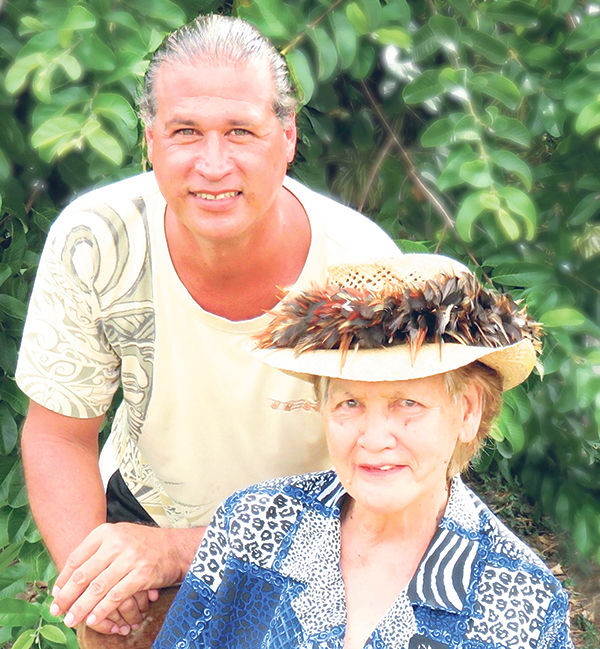When Hawaiian language instructor Keaoopuaokalani “Keao” NeSmith was growing up in Kekaha on the west side of Kauai in a large Hawaiian family, no one in his household spoke the Hawaiian language, a carry-over from laws passed in the 1800s that caused many Hawaiians to abandon their own culture in order to feel safe.
Although the laws hadn’t specifically banned the language or culture, the shaming for being Hawaiian was so severe that Keao’s mom, Odetta NeSmith, recalls “scrubbing off the Hawaiian at school because we were the bottom rung.”
Keao’s grandmother talked about being “swatted at school for speaking Hawaiian,” Odetta says. “My mother didn’t want us to be in that struggle, so the easiest way to do it was don’t speak Hawaiian at all. We all grew up that way.”
Keao explains: “My grandmother’s generation realized in order to survive, you had to give up speaking Hawaiian and being Hawaiian.”
But Keao had always longed to chat with his beloved grandmother in her native tongue, as well as to his neighbors in Kekaha who were originally from the island of Niihau and spoke Hawaiian fluently.
After his high school graduation from Kamehameha Schools in the 1980s, Keao figured out a way to learn the language.
Moving into his grandmother’s home in the small town of Hauula on Oahu’s north shore, “I insisted that she only speak Hawaiian to me,” he says. “She thought I was silly. I seriously wouldn’t let her speak English to me, to the point where sometimes I would ignore her if she spoke English to me.”
Soon, “she’d just carry on in Hawaiian and I’d absorb. Within about nine months, we were only speaking Hawaiian to each other,” he says. “A handful of times while we were washing dishes together, talking about stuff in Hawaiian, she would randomly turn to me and give me a big hug, and say in Hawaiian, ‘I’m so sorry I didn’t speak Hawaiian to your mom.’ “
About this time, Keao’s extended family began taking notice that he had learned to speak Hawaiian like his grandmother did, but the pair didn’t realize that what they were doing would affect anyone else.
Keao and his grandmother often rode crowded buses together, chatting away in Hawaiian “in our own bubble.” Others took notice.
“More than once, local people, often older ladies of my grandmother’s generation, would walk up to her, tap her on the shoulder and say, ‘Thank you for speaking Hawaiian to your grandson.’”
Nabbed to teach
Speaking Hawaiian had been a private matter for Keao, a way for him to connect more with his grandmother. He had “zero” ambitions to do anything more with his knowledge and in fact studied Japanese in high school and early college years, even working one summer in Japan while in high school.
But the Universe came knocking one day in the early 1990s while he was working for a computer software firm in Orem, Utah. One of his aunties lived nearby and his grandmother would come to visit from Hawaii for months at a time.
Soon they were getting together with other Hawaiian friends’ grandparents in Utah, laughing and talking in Hawaiian. Keao was “nabbed” by the families to teach a Hawaiian language course so they could all talk with their grandparents in Hawaiian, too.
After he moved back to Hawaii, Keao began studying Hawaiian language formally for the first time and noticed that the brand of Hawaiian normally taught was very American English-sounding.
“When they’re talking to me, I’m hearing the Hawaiian words, but the cadence and the words they’re choosing are very English-based,” Keao says. “They didn’t sound like native speakers. And the accent … “ He cringes at the memory as his voice trails off.
“Imagine learning French, knowing that you aren’t pronouncing it like a native, then trying to convince the world that, as an instructor, it’s not important that you don’t speak like a native,” he says. “It didn’t make sense to me.”
It’s more than semantics, Keao says. With only about 300 native speakers of Hawaiian remaining, by his estimate, the very real possibility exists that authentic Hawaiian could be lost if their language isn’t saved soon.
Absolutely Possible
There is hope. The largest number of native speakers of the Hawaiian language in the world are here on Kauai, primarily because of our connection with the island of Niihau, where the language has been preserved, Keao says.
“There are some differences between the Niihau dialect of Hawaiian and, say, my grandma’s Hawaiian,” but it’s real, he says, and more accurate than any Anglicized version of the language.
And Keao says it is “absolutely possible” for Hawaiian — and any other language — to be taught correctly by non-native speakers. It’s only a matter of learning how.
Change is underway, beginning in part with Keao’s master’s thesis in which he pointed out the differences between native speakers of Hawaiian and those who speak what he has coined “neo-Hawaiian,” the English-imbued version of Hawaiian.
Thanks to the Internet, where both his master’s and Ph.D. theses are posted, people around the planet have begun to adopt the word “neo” for language spoken differently from how native speakers do, and the awareness that language teachers must learn from native speakers to save traditional languages.
“The native speakers tell us how their language should be spoken,” he says, “not the other way around.”
Here in Hawaii, small changes can have big impact, such as Keao’s wish that announcements in Hawaii’s airports would be re-recorded by native speakers so that Hawaiian words would be pronounced with a real Hawaiian accent.
Keao’s grandmother died in 1999. “In my entire family, I’m the only one who speaks Hawaiian like my grandmother did,” he says. “I’m glad it got passed on while she was still alive.”
•••
Pamela Varma Brown is the publisher of “Kauai Stories,” and the forthcoming “Kauai Stories 2.”




